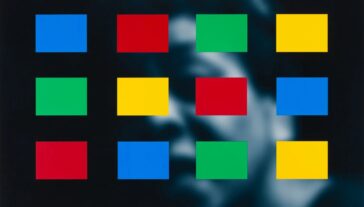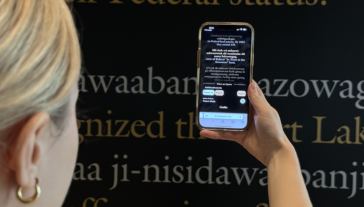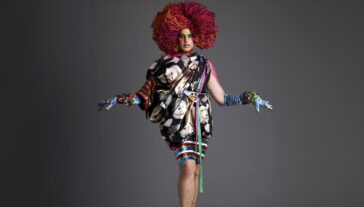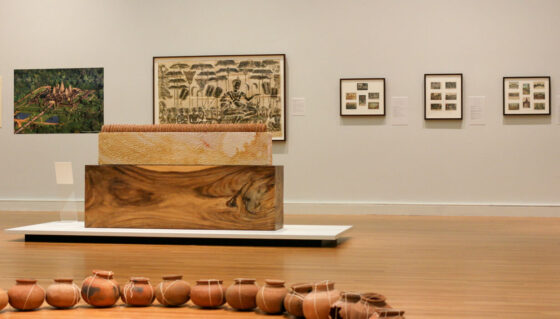UMMA to Open Exhibition Exploring Innovations and Turning Points in Cambodia’s Art Through 80 Historic and Contemporary Works
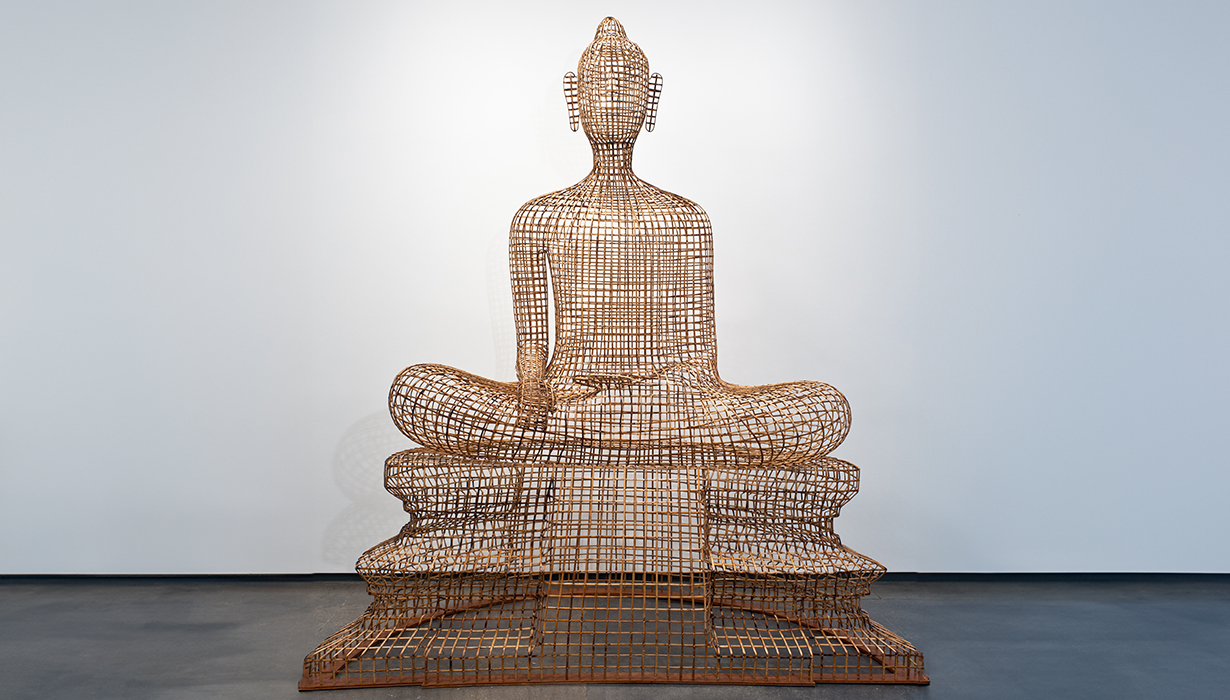
Ann Arbor, MI—November 16, 2023—On February 3, the University of Michigan Museum of Art (UMMA) will open Angkor Complex, an expansive exhibition exploring the art of Cambodia and its diaspora through 80 works, created from the 12th century to the present day. Angkor Complex explores distinct formal strategies and artistic innovations that emerged in the face of and in response to colonialism, significant social upheavals, war, and genocide. It features work from some of the foremost members of the modern and contemporary Cambodian art scene, including Vann Nath, Sopheap Pich, Svay Sareth, Amy Lee Sanford, and Leang Seckon, as well as significant historic works. Through architectural fragments, sculptural ensembles, paintings, lens-based media, shadow puppets, and performance pieces, the exhibition highlights the myriad ways in which artists leveraged the possibilities and power of art to honor the memory of the deceased, heal personal and collective angst, and nurture resilience.
Angkor Complex: Cultural Heritage and Post-Genocide Memory in Cambodia is guest curated by Nachiket Chanchani, an associate professor in the Department of the History of Art at the University of Michigan. Supported by grants from the National Endowment for the Arts, Michigan Arts and Cultural Council, and other agencies, the exhibition will remain on view through July 28, 2024.
At the core of the exhibition is the history of Angkor Wat, a state temple built in honor of a Hindu deity in the heyday of the cosmopolitan Khmer Empire (802-1431). When it was constructed, this sophisticated and sacred architectural ensemble, with its richly carved stone buildings, stood in a city of nearly a million people. As the Khmer Empire declined and the region became centered around farming, the temple became a Buddhist monastery. In 1863, when Cambodia became a French protectorate, France took Angkor Wat as its own cultural patrimony and began shipping architectural elements and sculptures to French art collections.
After Cambodia gained independence in 1953, successive short-lived regimes used Angkor Wat as an emblem of the past prosperity of the Khmer people. Pol Pot (1925–1998), a leader of the Khmer Rouge, oversaw the most autocratic and oppressive of these regimes from 1975 to 1979. In these dark years, Angkor Wat and other places of historical significance were both the site of armed skirmishes and places of refuge for displaced individuals. Today, Cambodians regard Angkor Wat as a sacred center, national symbol, and a site of memory. This history and symbolism serves as a critical anchor within the exhibition.
“Like Angkor Wat’s bullet-ridden walls, contemporary artworks from Cambodia and its diaspora bear the scars of a genocide and of related upheavals. They also allow us to critically appreciate the artistic strategies that evolved in response to significant generational trauma and to consider many of today’s global crises through the distinct lens of the Cambodian experience,” said Chanchani. “In Cambodia, sacred sculptures and edifices have long been acknowledged and experienced by walking around them in a clockwise circle. This rite is called circumambulation, and I invite audiences to the exhibition to experience the installation and the featured objects in the same way.”
Angkor Complex is organized in three thematic sections. The first, “Empire, Colony, and Nation,” explores the transformation of the region in the Mekong Basin, which straddles parts of present-day Cambodia, Laos, Thailand, and Vietnam, from a flourishing empire, to a settled colony, and to the established nation of Cambodia. Among the highlights in the section are an ink rubbing of a relief on Angkor Wat’s walls that plausibly portrays Suryavarman II, Builder of Angkor Wat, Seated in Majesty; a bronze Ritual conch with stand (12th-13th century), used in Vajrayana Buddhist rituals that empowered individuals who performed daring actions to escape from the cycle of life, death, and rebirth; Full Circle (2024), a sculptural installation by contemporary artist Amy Lee Sanford that grapples with her familial history, Cambodia’s collective losses, and the laborious tasks of reconstructing shattered lives and cultures; and artist Pete Pin’s photograph Shorty, 28, shows his Killing Fields tattoo, Philadelphia, PA (2011), which shows how the violence of the Cambodian genocide still flickers within descendants of survivors, even when physically removed from the trauma. Shorty and Pin are linked, and their histories spread to distant places like Philadelphia, which grapples with its own city violence. While this pain lingers, Shorty shows off his tattoo featuring Angkor Wat’s spires, the Philadelphia skyline, and the words ‘Killing Fields’ with balled fists suggesting a will to resist further oppression.
The second section, titled “Inheritance of Loss,” further examines the cycles and impacts of trauma caused by colonialism, invasion, enslavement, and migration in Cambodia—much of which has rarely been addressed in official courts of law. It includes a set of nine photographs by Vandy Rattana, titled Bomb Ponds (2009). In this acclaimed series, the artist draws attention to the history and legacy of U.S. military interventions in Cambodia (1969–73) during the Vietnam War (1955–75). The seemingly serene ponds of water amid fertile vegetation are in fact craters in chemical-strewn fields caused by over two million tons of secret American bombs. Also featured in the section are a poem by Sarith Peou, titled Scars, which addresses the mutilation of life during the civil war and Khmer Rouge years; and Sopheap Pich’s Seated Buddha – Abhaya Mudra (2012), which articulates only the shell of the Buddha’s body. As the sculpture oscillates between presence and absence, immanence and transcendence, it queries Buddhist notions of reincarnation, impermanence, and ultimate liberation.
The final section of Angkor Complex is “On Reparation,” which explores the theft of sacred objects from Cambodia and the slow process of repatriation. Artist Leang Seckon’s mixed media work on canvas, titled Journey Crossing the Border (2016), offers a meditation on the loss of Cambodia’s cultural patrimony to the international art market and the perils sculptures face crossing borders. The section also includes an example of a Guardian Lion (from possibly the 12th century). The perimeters of Angkor Wat and other Cambodian temples are dotted with small and large sandstone sculptures of lions. Since the 19th century, these lions have fascinated Western travelers, and many sculptures were removed from their original contexts to be displayed in public and private collections. The Western obsession with these sculptures has also led to the production of replicas, sometimes making it difficult to determine whether objects are originals or more recent facsimiles.
“Angkor Complex provides a singular opportunity to engage with turning points in the distinct cultural and political history of Cambodia and the surrounding regions through an incredible range of objects. The works in the exhibition reflect both the ingenuity of historic makers and the depth and breadth of contemporary production by Cambodian and diasporic artists,” said Christina Olsen, UMMA’s Director. “At the same time, the exhibition invites consideration of today’s broader cultural, social, and political happenings and fosters dialogue about the lessons that can be taken from the pain and resilience of the Cambodian people.”
In Cambodia, sacred sculptures and edifices have long been acknowledged and experienced by walking around them in a clockwise circle. This rite is called circumambulation, and I invite audiences to the exhibition to experience the installation and the featured objects in the same way.
More from UMMA
